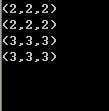标签:style blog http color os 文件 io 数据
上一节主要讲解了C++里运算符重载函数,在看了单目运算符(++)重载的示例后,也许有些朋友会问这样的问题。++自增运算符在C或C++中既可以放在操作数之前,也可以放在操作数之后,但是前置和后置的作用又是完全不同的(q前置运算符:先加1,再赋值;后置运算符:先赋值,再加1)。那么要怎么重载它们,才可以有效的区分开来呢?今天我就来说说C++中是怎么处理前置运算符和后置运算符的重载的。以及介绍一下插入运算符(>>)和提取运算符(<<)的重载。
1.在C++里编译器是根据运算符重载函数参数表里是否插入关键字int来区分前置还是后置运算。比如:
#include "stdafx.h" #include <iostream> class TDPoint//三维坐标 { private: int x; int y; int z; public: TDPoint(int x=0,int y=0,int z=0) { this->x=x; this->y=y; this->z=z; } TDPoint operator++();//成员函数重载前置运算符++ TDPoint operator++(int);//成员函数重载后置运算符++ friend TDPoint operator++(TDPoint& point);//友元函数重载前置运算符++ friend TDPoint operator++(TDPoint& point,int);//友元函数重载后置运算符++ void showPoint(); }; TDPoint TDPoint::operator++() { ++this->x; ++this->y; ++this->z; return*this;//返回自增后的对象 } TDPoint TDPoint::operator++(int) { TDPoint point(*this); this->x++; this->y++; this->z++; return point;//返回自增前的对象 } TDPoint operator++(TDPoint& point) { ++point.x; ++point.y; ++point.z; return point;//返回自增后的对象 } TDPoint operator++(TDPoint& point,int) { TDPoint point1(point); point.x++; point.y++; point.z++; return point1;//返回自增前的对象 } void TDPoint::showPoint() { std::cout<<"("<<x<<","<<y<<","<<z<<")"<<std::endl; } int main() { TDPoint point(1,1,1); point.operator++();//或++point point.showPoint();//前置++运算结果 point=point.operator++(0);//或point=point++ point.showPoint();//后置++运算结果 operator++(point);//或++point; point.showPoint();//前置++运算结果 point=operator++(point,0);//或point=point++; point.showPoint();//后置++运算结果 return0; }
结果:

从示例代码里可以清楚的看出,后置运算符重载函数比前置运算符重载函数多了一个int类型的参数,这个参数只是为了区别前置和后置运算符,此外没有任何作用。所以在调用后置运算符重载函数时,int类型的实参可以取任意值。
2.在C++中,操作符"<<"和">>"被定义为左位移运算符和右位移运算符。由于在iostream头文件中对它们进行了重载,使得它们可以用基本数据的输出和输入。
#include "stdafx.h" #include <iostream> int main() { int a=10; std::cout<<"a="<<a<<std::endl;//运算符"<<"重载后用于输出 a=a>>2;//右移运算符 std::cout<<"右移2位:a="<<a<<std::endl; std::cout<<"请输入一个整数a:"; std::cin>>a;//运算符">>"重载后用于输入 a=a<<2;//左移运算符 std::cout<<"左移2位:a="<<a<<std::endl; return0; }
结果:

插入运算符"<<"是双目运算符,左操作数为输出流类ostream的对象,右操作数为系统预定义的基本类型数据。头文件iostrem对其重载的函数原型为ostream& operator<<(ostream& ,类型名);类型名就是指基本类型数据。但如果要输出用户自定义的类型数据的话,就需要重载操作符"<<",因为该操作符的左操作数一定为ostream类的对象,所以插入运算符"<<"只能是类的友元函数或普通函数,不能是其他类的成员函数。一般定义格式:
ostream& operator<<(ostream& ,自定义类名&);
提取运算符">>"也是如此,左操作数为istream类的对象,右操作数为基本类型数据。头文件iostrem对其重载的函数原型为istream& operator>>(istream& ,类型名);提取运算符也不能作为其他类的成员函数,可以是友元函数或普通函数。它的一般定义格式为:
istream& operator>>(istream& ,自定义类名&);
我还是用上一节用的Complex类(复数类)来举例:
#include "stdafx.h" #include <iostream> class Complex //复数类 { private://私有 double real;//实数 double imag;//虚数 public: Complex(double real=0,double imag=0) { this->real=real; this->imag=imag; } friend std::ostream&operator<<(std::ostream& o,Complex& com);//友元函数重载提取运算符"<<" friend std::istream&operator>>(std::istream& i,Complex& com);//友元函数重载插入运算符">>" }; std::ostream&operator<<(std::ostream& o,Complex& com) { std::cout<<"输入的复数:"; o<<com.real; if(com.imag>0) o<<"+"; if(com.imag!=0) o<<com.imag<<"i"<<std::endl; return o; } std::istream&operator>>(std::istream& i,Complex& com) { std::cout<<"请输入一个复数:"<<std::endl; std::cout<<"real(实数):"; i>>com.real; std::cout<<"imag(虚数):"; i>>com.imag; return i; } int main() { Complex com; std::cin>>com; std::cout<<com; return0; }
结果:

标签:style blog http color os 文件 io 数据
原文地址:http://www.cnblogs.com/wuchanming/p/3879532.html